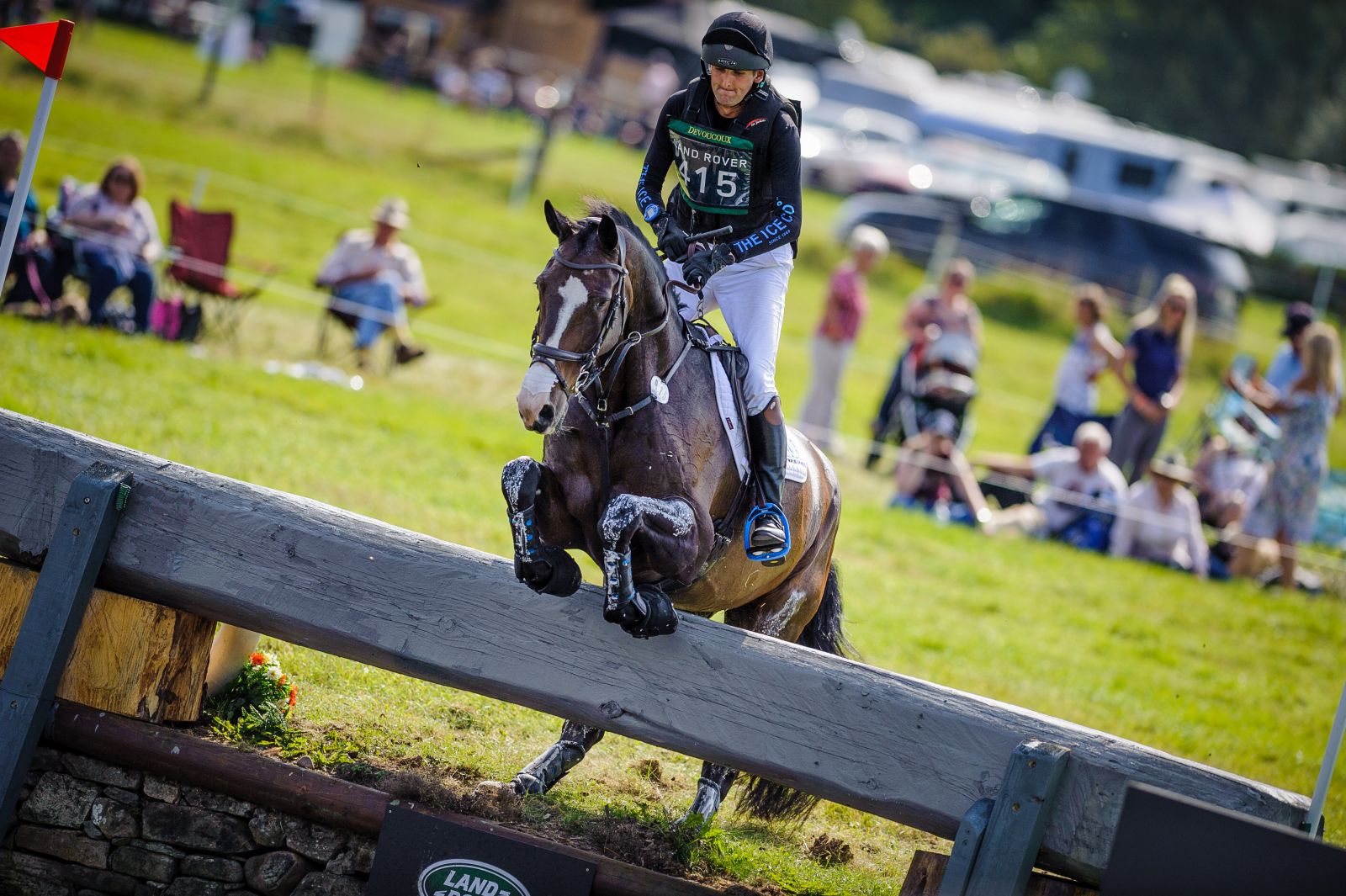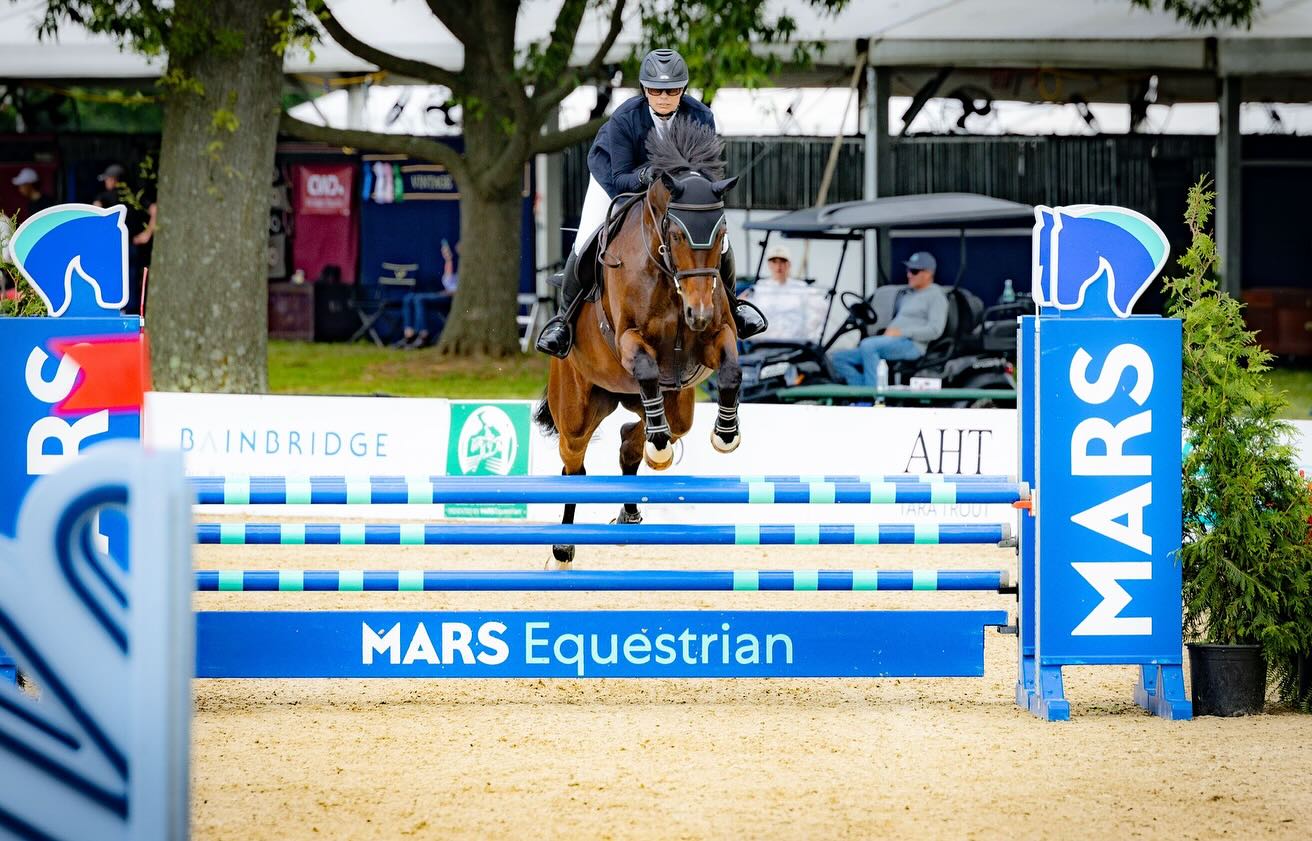
Phil Brown and Harry Robinson. Photo by Tilly Berendt.
Though he’s moved back home to Yorkshire recently to base his business closer to his family, for many years, eventer Phil Brown was based just next door to Burghley: so close, in fact, that he could see the famous façade of the house from his arena as he worked his horses, day in and day out, come rain or shine.
“That was major motivation,” he says with a smile. “You could see it from our fields, from the arena — and having that there made it all the more special when I finally got there as a competitor.”
That ‘finally’ moment came last year: riding the then-fourteen-year-old British-bred gelding Harry Robinson – and yes, a horse with a human first and surname IS the most charming thing you’ll stumble upon today — he didn’t just make a long-anticipated debut at the event that had fuelled his drive for so many years, he completed the thing, too.
“We went quite steady!” he laughs, referring to the 62 time penalties he picked up while piecing together their clear round. “We were a good two minutes over, but he just kept plugging along, because he really loves his job.”
Harry’s not alone in that: as a local rider, Phil came to Burghley — which wasn’t just his debut at the event, but his debut five-star, too — with a large and enthusiastic support crew of friends and family. But as the week unfolded, and as everyone on site universally fell in love with the sweet, floppy-eared, splashy-faced gelding, it was impossible not to take note of how much Phil, too, was relishing the moment. Their dressage score, a respectable debut of 35.3, didn’t have them challenging the leaders, but Phil returned to the mixed zone for a post-ride debrief with journalists with the joy of someone who’d taken the lead; likewise, when he returned from cross-country, he did so buoyed by sheer thrill, gratitude, and a palpable love for his horse. By the end of the week, it was impossible not to root for Phil, and not to catch that contagious smile as he embraced both the extraordinary learning opportunity around him, and the realisation of a dream he’d held throughout his career.
“We had a bit of a laugh about it in the talk area last year, but I chose to do Burghley as my debut because — well, nobody in this country dreams of Pau, do they? That probably sounds like quite a bad thing to say, but we do grow up dreaming of Badminton and Burghley. I’m from Yorkshire, and so Bramham was always a really big thing for me, and once we’d done that [Phil jumped a swift clear in 2016 with Miss Brodie], I thought, let’s try for a five-star. Because I was down in the same area, it felt like the obvious one — but also the most scary!”

Phil Brown and Harry Robinson. Photo by Tilly Berendt.
Part of what made last year so special for Phil was the realisation that no matter how tightly you hold onto a dream, and how close you think you’ve come to grasping it, it’s never guaranteed that you’ll get there.
“I actually came so close to getting here six years previously,” he says. “But then that horse broke down; the rules had changed and we had to do another long format event for our qualification, and the horse picked up an injury there. So we never got our chance, and it’s taken six years to work myself back to that stage.”
If someone had told him that it would be Harry Robinson with whom he’d finally tick the box, Phil admits, “I wouldn’t have believed them!” Though they’d been together since the gelding’s six-year-old year, he was sold when he stepped up to Advanced — but within nine months, he’d bounced back to Phil’s yard, “because they just didn’t get on with him that well; they found him a bit much,” he explains. “They rang me and asked if I’d like him back, and because my horse had picked up an injury, I said, ‘yeah, why not?'”
Nigel and Susie Bushby, who are old family friends of Phil’s and live just down the road from his parents’ house, decided to join in on the gamble, and bought the horse under the banner of their own family business, Orbit Electrical Services Ltd. And then, everyone got to work, building a partnership with a horse that, Phil confesses, is a bit of a quirky soul.
“He’s so kind on the ground, like a really lovely, big Labrador,” he says fondly. “He’s the most loveable horse and everybody that works on the yard loves him — and I love him; his owners love him. But to ride he’s a real hothead. He’s kind of a Jekyll and Hyde — there’s absolutely no nastiness in him, but he’s always so overeager to get the job done that if you try to over-control him, he can have a bit of a tantrum.”
But, he continues, that’s what makes him a great partner for the biggest courses in the world: “Because he’s like that, he loves his cross-country. He just wants to get on with the job and do it for you — and one thing about Harry is that he just keeps trying, no matter what. When you look back at photographs and videos from last year, from the beginning to the end of that course, his ears are pricked and he’s loving what he’s doing.”

Phil Brown’s handsome Harry Robinson. Photo by Tilly Berendt.
There’s a wobble of emotion in Phil’s voice when he talks about what Harry means to him — not just as the horse that found his way home, nor just as a rallying point for his family and family-by-proxy in the Bushby clan, but because he carried him to the zenith of his dreams.
“Joanne, who was the woman who bought him for that nine months or so, sends me messages saying, ‘it was just meant to be’ — it’s so special,” he says. But he’s not resting on his laurels, either: with that dream accomplished last year, he’s got his sights set on a return for this year’s Burghley, with everything he learned last week guiding and influencing him.
“Last year, my goal was just, ‘let’s just get there’,” he says. “When we arrived, I was like, ‘whatever happens…”, but then it went so beautifully that we came away thinking, ‘wow, I’ve done that now, what now?!’ But then to go into this season not just knowing how to prepare, but also not having to chase down qualifications and MERs, that’s felt a bit weird! It’s been the goal all year, and we’ve been steadily building up to it with some four-star runs. The biggest thing, though, is that I now know I’m capable, and I know he’s capable. Getting him fit enough was a big priority for me last year; I thought, ‘even if it means he blows up in the dressage, he has to be fit enough’. And now, knowing that that system works gives me so much confidence in the fact that it can happen.”
But, he adds sagely, “it’s five-star. Just because you’ve done it once, doesn’t mean you can take that for granted. But I do feel a bit more relaxed about it. Last year was the unknown; you think you’re doing everything right, but you can never actually know for sure until you’re doing it. He’s not a lot of Thoroughbred — he’s warmblood and Irish, but I found that he’ll just keep going. But until you’re in that situation, you just don’t know if they’ll cope with that next step. You have to go into it thinking, ‘we’ll give it a go and just be sensible, and if it’s right, it’s right, and if it’s not, I’ll pull up’.”
Smart clears in the CCI4*-S classes at Bramham and Aston this year will put them well on the right track, while Harry’s once-annual 20, which he picked up at Hartpury last week, will give them those last-minute sharpeners to work on — but whatever happens, Phil and his ‘boomerang’ horse will be enjoying every step of the way. And if you want to follow along with them and give them a cheer as they tackle Derek di Grazia’s tough track, just follow the cheers — as the young rider coach for the East Midlands, he’ll have voracious support scattered throughout the track. Lend them your voice, too; you’ll be rewarded with a display of horse-first eventing and a tangible, ineffable love for the sport.






































